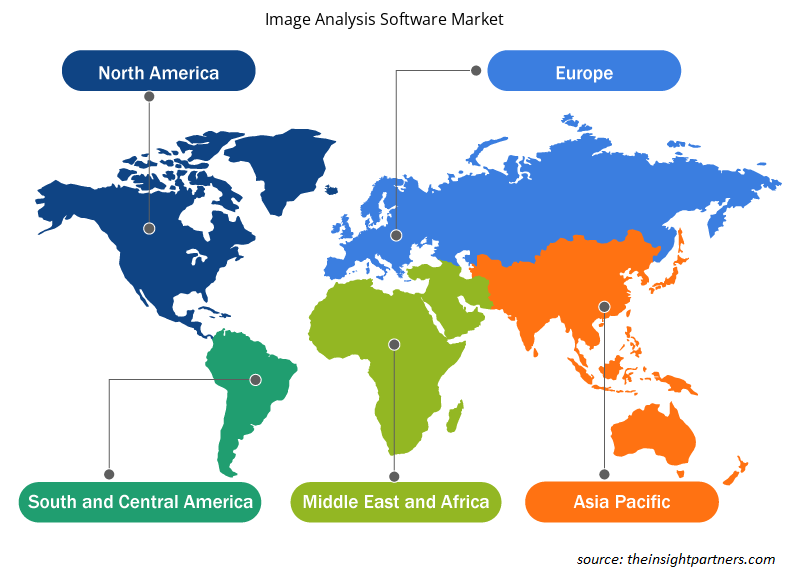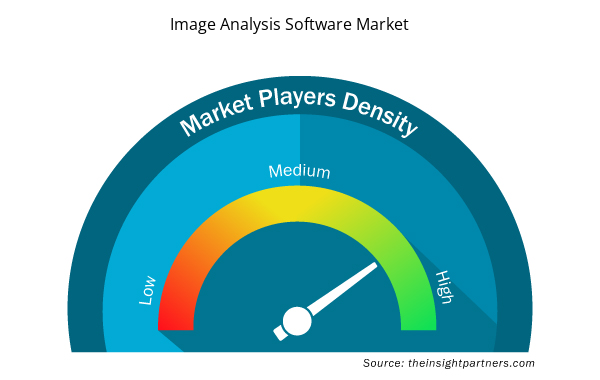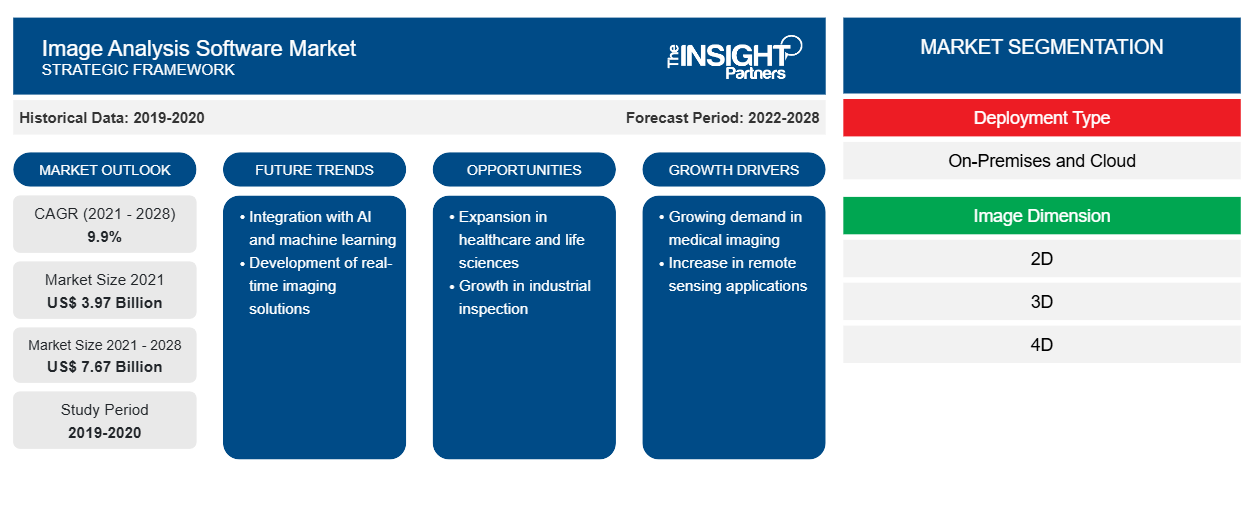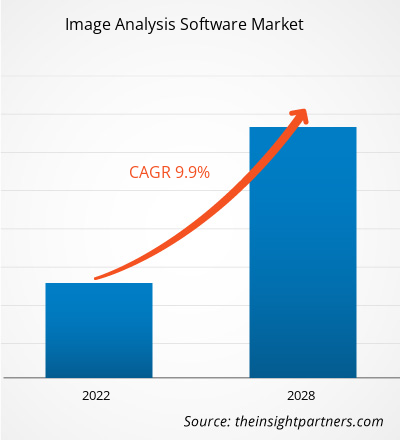[研究报告] 图像分析软件市场预计将从 2021 年的 39.7093 亿美元增长到 2028 年的 76.7216 亿美元;预计 2021 年至 2028 年的复合年增长率为 9.9%。CAGR of 9.9% from 2021 to 2028.
图像分析软件市场,通常称为图像分析市场,使用数字图像处理技术帮助从图片(主要是数字图像)中提取有价值的数据。图像分析任务范围很广,从简单的扫描条形码标签到复杂的人脸识别。计算机需要处理大量数据、需要复杂计算的工作以及提取定量数据。当计算机或电气设备分析图片以提取可用信息时,这被称为数字图像分析或计算机图像分析。它将模式识别、数字几何和信号处理整合到计算机或机器视觉和医学成像领域。
由人工智能 (AI) 和机器学习 (ML) 驱动的图像分析软件应用程序重新定义了汽车行业。它现在被用于汽车制造业的设计、供应链、生产和后期制作。此外,人工智能和机器学习还被用于“驾驶辅助”和“驾驶员风险评估”系统,彻底改变了交通运输行业。人工智能也在改变各种售后服务,如预测性维护和保险。在汽车行业,机器学习已经推动了新智能产品的开发和工作方法的改进。
查找形状、识别边缘、降低噪声、计算对象数量以及生成纹理分析或图片质量的统计数据都是图像分析任务的示例。它是二维 (2D) 或三维 (3D) 数字图片的定量或定性表征,其中计算机视觉分析 2D 图片,而医学成像分析 3D 图像。图像分析软件广泛用于显微镜图像分析和科学图像研究。图像分析软件市场的增长主要由医疗保健和生命科学行业广泛采用该软件所推动。
定制此报告以满足您的需求
您可以免费定制任何报告,包括本报告的部分内容、国家级分析、Excel 数据包,以及为初创企业和大学提供优惠和折扣
- 获取此报告的关键市场趋势。这个免费样品将包括数据分析,从市场趋势到估计和预测。
COVID-19 疫情对图像分析软件市场的影响
COVID-19 疫情使图像分析软件市场受益。由于 COVID-19 疫情和远程工作环境的发展,企业面临新的挑战。COVID-19 疫情凸显了各行各业的公司采用数字技术并利用图像分析软件市场解决方案和服务的潜力来优化运营和成本的必要性,这将进一步提高 IT 工具的投资回报率。此外,2020 年的疫情给全球图像分析软件市场运营带来了一系列挑战。由于 COVID-19 病例的增加,发达经济体的医疗基础设施崩溃。因此,公共医疗紧急情况需要政府和市场参与者进行干预,并通过合作开展研发计划来协助恢复图像分析软件市场的运营和收入,以弥补预测期内的损失。此外,增加的投资对未来几年的图像分析软件市场来说是个好兆头。
图像分析软件市场洞察 对
支持图像分析的安全应用程序和产品的需求不断增长
公司已经开始看到从非结构化数据中获取资源的潜力。他们可以使用照片或视频在零售、娱乐、保险索赔和其他行业中创造独特且引人入胜的消费者体验。图像分析用于支持越来越多的企业用例。深度学习和图像分析的这些实际应用源于机器学习算法的进步、数据集的可用性以及具有允许实时处理的平台的强大技术。美国许多机场正在升级其设备,以启用指纹或虹膜扫描等生物识别技术作为替代安全检查技术。公司预计通过部署图像分析技术将乘客从到达区通过安检转移到登机口,将显著提高运力。
图像分析软件市场 - 部署类型细分洞察
根据部署,图像分析软件市场分为本地和云。本地软件安装和运行在用户或组织场所的计算机上,而不是在远程设施(例如服务器场或云)上。由于本地软件提供了更好的灵活性、稳定性和安全性,许多市场参与者现在都在销售本地软件。例如,本地 Imagga 的视觉 AI 解决方案可在公司的私有本地服务器上全面部署。数据敏感型组织可以使用 Imagga 屡获殊荣的视觉 AI 技术执行自动标记、自动分类、颜色提取、自定义训练和面部识别,同时完全遵守隐私法律法规。
图像分析软件市场 - 图像维度细分洞察
根据图像维度,图像分析软件市场分为 2D、3D 和 4D。2D 图像是使用 x 轴和 y 轴创建的。传统上,2D 图像被用作动画和视频的来源。这是一项历史悠久的较老技术,但它仍然是一种经典技术。这些图像简单、视觉吸引力强,并且易于消费,不会让客户感到太过不知所措或不安。2D 图像在动画和视频游戏中很常见,因为它们在屏幕上提供了逼真而平坦的运动视角。因此,业内多家企业现在提供用于分析 2D 照片的软件。例如,Media Cybernetics, Inc. 的 Image-Pro Plus 2D 图像分析软件有助于简单地收集照片、计数、测量和分类物品,并自动完成工作。该软件包包括显微镜控制、图像捕获、测量、计数/尺寸和宏开发功能。
图像分析软件市场 - 行业垂直细分洞察
根据行业垂直领域,图像分析软件市场细分为医疗保健和生命科学、制造业、学术界、矿产、金属和石油等。在医疗行业,图像分析软件可用于神经病学、心脏病学、骨科、牙科和肿瘤学等各个领域。该软件可以读取 X 射线、MRI、CT 扫描、PET 扫描和超声波生成的图像。因此,可以自动化和加速流程,以避免手动工作并节省时间。该软件可以学习识别这些照片中的特定特征,使诊断过程快速准确。医学图像处理软件具有很多功能。基于人工智能的解决方案可以检测异常和潜在的危险异常,还可以显示患者是癌症还是良性肿瘤。除了常规的 2D 图像(显示随时间变化的图像)外,该软件还可以读取 3D 和所谓的 4D 照片。
图像分析软件市场
图像分析软件市场参与者专注于新产品创新和开发,通过整合先进技术和功能来参与竞争。2021 年 10 月,Clemex Vision 包含了针对马氏体、铁素体和奥氏体晶粒的独特说明以及 ML 功能。这些新的自动化方法已添加到现有软件的工具箱中,以提供一种快速准确的技术来目视识别困难的微观结构。
根据部署类型,图像分析软件市场分为本地和云。根据图像维度,图像分析软件市场细分为 2D、3D 和 4D。根据行业垂直领域,图像分析软件市场细分为医疗保健和生命科学、制造业、学术界、矿产、金属和石油等。根据地区,全球图像分析软件市场细分为北美、欧洲、亚太地区、中东和非洲以及南美。
图像分析软件市场区域洞察
Insight Partners 的分析师已详尽解释了预测期内影响图像分析软件市场的区域趋势和因素。本节还讨论了北美、欧洲、亚太地区、中东和非洲以及南美和中美洲的图像分析软件市场细分和地理位置。

- 获取图像分析软件市场的区域特定数据
图像分析软件市场报告范围
| 报告属性 | 细节 |
|---|---|
| 2021 年市场规模 | 39.7亿美元 |
| 2028 年市场规模 | 76.7 亿美元 |
| 全球复合年增长率(2021 - 2028) | 9.9% |
| 史料 | 2019-2020 |
| 预测期 | 2022-2028 |
| 涵盖的领域 | 按部署类型
|
| 覆盖地区和国家 | 北美
|
| 市场领导者和主要公司简介 |
|
市场参与者密度:了解其对商业动态的影响
图像分析软件市场正在快速增长,这得益于最终用户需求的不断增长,而这些需求又源于消费者偏好的不断变化、技术进步以及对产品优势的认识不断提高等因素。随着需求的增加,企业正在扩大其产品范围,进行创新以满足消费者的需求,并利用新兴趋势,从而进一步推动市场增长。
市场参与者密度是指在特定市场或行业内运营的企业或公司的分布情况。它表明在给定市场空间中,相对于其规模或总市场价值,有多少竞争对手(市场参与者)存在。
在图像分析软件市场运营的主要公司有:
- 安得西斯公司
- Bio-Rad 实验室有限公司
- 牛津仪器
- Clemex 技术公司
- 媒体控制论公司
免责声明:上面列出的公司没有按照任何特定顺序排列。

- 获取图像分析软件市场顶级关键参与者概述
图像分析软件市场 – 公司简介
- 安得西斯公司
- Bio-Rad 实验室有限公司
- 牛津仪器
- Clemex 技术公司
- 媒体控制论公司
- MIPAR 软件有限公司
- 奥林巴斯公司
- 帕克西特
- 珀金埃尔默公司
- TissueGnostics GmbH
- 徕卡显微系统有限公司
- MVTec 软件有限公司
- 卡尔蔡司公司
- Scale AI 公司
- Labelbox公司
- V7有限公司
- 历史分析(2 年)、基准年、预测(7 年)及复合年增长率
- PEST 和 SWOT 分析
- 市场规模价值/数量 - 全球、区域、国家
- 行业和竞争格局
- Excel 数据集



Report Coverage
Revenue forecast, Company Analysis, Industry landscape, Growth factors, and Trends

Segment Covered
This text is related
to segments covered.

Regional Scope
North America, Europe, Asia Pacific, Middle East & Africa, South & Central America

Country Scope
This text is related
to country scope.
常见问题
North America held the largest market share in year 2020, along with the notable revenue generation opportunities in Europe and APAC.
Key companies in the image analysis software market include ADCIS SA; Bio-Rad Laboratories, Inc.; Oxford Instruments; Clemex Technologies, Inc.; Media Cybernetics, Inc.; MIPAR Software LLC; Olympus Corporation; Pax-it; PerkinElmer, Inc.; TissueGnostics GmbH; Leica Microsystems GmbH; MVTec Software GmbH; Carl Zeiss AG; Scale AI, Inc.; Labelbox, Inc; and V7 Ltd.
The Image analysis software market is segmented into on-premises and cloud based on the deployment type. The global image analysis software market is dominated by on-premise segment in 2020, which accounted for more than ~ 60%.
Visual AI allows new and experienced users to effortlessly construct and deploy more accurate and explicable machine learning models with photos through community hardware. Computer vision will enable users to manipulate pictures as they would any other type of data. Enterprise AI systems automate the preparation, selection, and training of a wide range of cutting-edge deep learning models so that the optimal deployment model may be recommended. As social separation becomes the new normal, it's more important than ever to watch and monitor people's gatherings and movements. Standard Operating Procedures (SOPs) must be implemented and tracked in real-time by businesses. Employees can maintain safe, specified distances from one another throughout shifts while following conventional practices thanks to computer algorithms that evaluate data from on-site video cameras. Retailers may utilize AI and machine learning tools to keep track of the distances between their warehouse employees. When a divergence from typical behavior is detected, these tools issue real-time alerts., which in turn is likely to gain momentum for the image analysis software market over the forecasted period.
AI is becoming the next frontier in digital transformation, and when integrated into processes, it can deliver value and impact across all facets of a company. AWS, Microsoft, and Google are all aggressively investing in improving their image analysis software solutions to improve in-store and online retail performance. Due to the emergence of COVID-19, demand for cloud-based services has increased even more. Intelligence Retail, a supplier of computer vision and AI for merchandising solutions, uses IBM's cloud and analysis solution, which includes cutting-edge Graphics Processing Units (GPUs), to help businesses increase sales, lower audit costs, improve performance, and increase customer loyalty. For example, Trax and Google Cloud teamed in 2019 to use Google's cloud and edge computing technologies, as well as Trax's image recognition and machine learning capabilities, to successfully manage in-store inventory and every SKU on the shelf with actionable real-time insights. These strategies would promote the future growth of the image analysis market in the forecasted period.
Growing demand for image analysis-enabled security applications and products
Increasing demand for image analysis in the automotive industry
Trends and growth analysis reports related to Technology, Media and Telecommunications : READ MORE..
The List of Companies - Image Analysis Software Market
- ADCIS SA
- Bio-Rad Laboratories, Inc.
- Oxford Instruments
- Clemex Technologies, Inc.
- Media Cybernetics, Inc.
- MIPAR Software LLC
- Olympus Corporation
- Pax-it
- PerkinElmer, Inc.
- TissueGnostics GmbH
- Leica Microsystems GmbH
- MVTec Software GmbH
- Carl Zeiss AG
- Scale AI, Inc.
- Labelbox, Inc
- V7 Ltd
The Insight Partners performs research in 4 major stages: Data Collection & Secondary Research, Primary Research, Data Analysis and Data Triangulation & Final Review.
- Data Collection and Secondary Research:
As a market research and consulting firm operating from a decade, we have published and advised several client across the globe. First step for any study will start with an assessment of currently available data and insights from existing reports. Further, historical and current market information is collected from Investor Presentations, Annual Reports, SEC Filings, etc., and other information related to company’s performance and market positioning are gathered from Paid Databases (Factiva, Hoovers, and Reuters) and various other publications available in public domain.
Several associations trade associates, technical forums, institutes, societies and organization are accessed to gain technical as well as market related insights through their publications such as research papers, blogs and press releases related to the studies are referred to get cues about the market. Further, white papers, journals, magazines, and other news articles published in last 3 years are scrutinized and analyzed to understand the current market trends.
- Primary Research:
The primarily interview analysis comprise of data obtained from industry participants interview and answers to survey questions gathered by in-house primary team.
For primary research, interviews are conducted with industry experts/CEOs/Marketing Managers/VPs/Subject Matter Experts from both demand and supply side to get a 360-degree view of the market. The primary team conducts several interviews based on the complexity of the markets to understand the various market trends and dynamics which makes research more credible and precise.
A typical research interview fulfils the following functions:
- Provides first-hand information on the market size, market trends, growth trends, competitive landscape, and outlook
- Validates and strengthens in-house secondary research findings
- Develops the analysis team’s expertise and market understanding
Primary research involves email interactions and telephone interviews for each market, category, segment, and sub-segment across geographies. The participants who typically take part in such a process include, but are not limited to:
- Industry participants: VPs, business development managers, market intelligence managers and national sales managers
- Outside experts: Valuation experts, research analysts and key opinion leaders specializing in the electronics and semiconductor industry.
Below is the breakup of our primary respondents by company, designation, and region:

Once we receive the confirmation from primary research sources or primary respondents, we finalize the base year market estimation and forecast the data as per the macroeconomic and microeconomic factors assessed during data collection.
- Data Analysis:
Once data is validated through both secondary as well as primary respondents, we finalize the market estimations by hypothesis formulation and factor analysis at regional and country level.
- Macro-Economic Factor Analysis:
We analyse macroeconomic indicators such the gross domestic product (GDP), increase in the demand for goods and services across industries, technological advancement, regional economic growth, governmental policies, the influence of COVID-19, PEST analysis, and other aspects. This analysis aids in setting benchmarks for various nations/regions and approximating market splits. Additionally, the general trend of the aforementioned components aid in determining the market's development possibilities.
- Country Level Data:
Various factors that are especially aligned to the country are taken into account to determine the market size for a certain area and country, including the presence of vendors, such as headquarters and offices, the country's GDP, demand patterns, and industry growth. To comprehend the market dynamics for the nation, a number of growth variables, inhibitors, application areas, and current market trends are researched. The aforementioned elements aid in determining the country's overall market's growth potential.
- Company Profile:
The “Table of Contents” is formulated by listing and analyzing more than 25 - 30 companies operating in the market ecosystem across geographies. However, we profile only 10 companies as a standard practice in our syndicate reports. These 10 companies comprise leading, emerging, and regional players. Nonetheless, our analysis is not restricted to the 10 listed companies, we also analyze other companies present in the market to develop a holistic view and understand the prevailing trends. The “Company Profiles” section in the report covers key facts, business description, products & services, financial information, SWOT analysis, and key developments. The financial information presented is extracted from the annual reports and official documents of the publicly listed companies. Upon collecting the information for the sections of respective companies, we verify them via various primary sources and then compile the data in respective company profiles. The company level information helps us in deriving the base number as well as in forecasting the market size.
- Developing Base Number:
Aggregation of sales statistics (2020-2022) and macro-economic factor, and other secondary and primary research insights are utilized to arrive at base number and related market shares for 2022. The data gaps are identified in this step and relevant market data is analyzed, collected from paid primary interviews or databases. On finalizing the base year market size, forecasts are developed on the basis of macro-economic, industry and market growth factors and company level analysis.
- Data Triangulation and Final Review:
The market findings and base year market size calculations are validated from supply as well as demand side. Demand side validations are based on macro-economic factor analysis and benchmarks for respective regions and countries. In case of supply side validations, revenues of major companies are estimated (in case not available) based on industry benchmark, approximate number of employees, product portfolio, and primary interviews revenues are gathered. Further revenue from target product/service segment is assessed to avoid overshooting of market statistics. In case of heavy deviations between supply and demand side values, all thes steps are repeated to achieve synchronization.
We follow an iterative model, wherein we share our research findings with Subject Matter Experts (SME’s) and Key Opinion Leaders (KOLs) until consensus view of the market is not formulated – this model negates any drastic deviation in the opinions of experts. Only validated and universally acceptable research findings are quoted in our reports.
We have important check points that we use to validate our research findings – which we call – data triangulation, where we validate the information, we generate from secondary sources with primary interviews and then we re-validate with our internal data bases and Subject matter experts. This comprehensive model enables us to deliver high quality, reliable data in shortest possible time.


 获取此报告的免费样本
获取此报告的免费样本